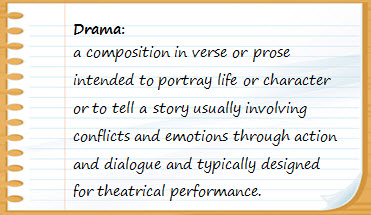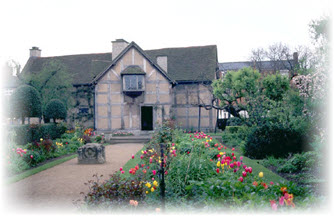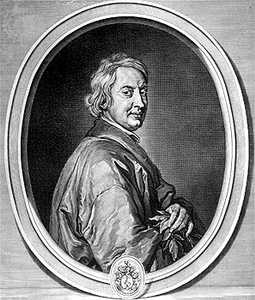
Tragedy and Drama

Unit Overview
In this unit, you will study the different forms of drama. You will focus on the oldest and most popular form called tragedy. You will look at the characteristics of the different forms and learn to distinguish each form. You will read the great tragedy King Lear by William Shakespeare and watch a video connecting the work to what now defines tragedy. You will also take an in depth study of Shakespeare’s life, influence on theatre and his acclaimed work on tragedies.
1. Drama
Drama is a term that we hear frequently in daily life. In many cases, it has a negative connotation and is something most people want to avoid. As illustrated in the following definition from Merriam-Webster, drama involves conflict and emotion, which is not always easy to face.

In this unit, we will look at the different forms of serious drama. What all of these forms of drama have in common is that each creates a special experience for the audience. Serious drama generates a thought provoking, realistic view into challenges that humans are called to face. The audience is asked to become emotionally involved with the characters onstage. They are asked to invest in the actions and words that they see and hear onstage.
As we learned in the previous unit, the goal of the playwright is to make a human connection with the audience. In serious drama, this includes the portrayal of the pain, suffering, heartbreak, loneliness, fear and terror of real life. What makes this a desirable form of entertainment? Well, we can look back at one simple answer: the human connection. The audience likes to connect with characters that are like themselves. They like the ability to see how a similar situation is played-out. They like the comfort of knowing others are going through what they might be going through. This is the human connection. This is why drama is still so important today.
Let’s look at the four forms of drama that we will study in this unit.
Some of the forms you may recognize by name. Others might become more familiar after we take a closer look. The best-known and most widely performed form of drama is tragedy.
 Now answer questions 1 through 3.
Now answer questions 1 through 3.
2. Tragedy
Any misfortune or disaster is sometimes referred to as a Tragedy. In reference to theatre, tragedy is known as the imaginative depiction of the tragic figure. Tragedy is the oldest and most fundamental form of drama. Within tragedy, there is always a universal significance as well as the foundation of moral and philosophical implications. What it all boils down to is one simple question…“why?” Why are people so cruel to one another? Why do bad things happen to good people? Why can’t the world be more just?
In tragedy, it seems as though the innocent, the naïve and the good are always being persecuted. The “why” questions that we ask can lead us to unforgettable moments of human achievement. We see a representation of undeniable courage, strength and perseverance as the characters are faced with and overcome the obstacles placed before them.
There are two forms of tragedy. The first, traditional tragedy, are those plays written in the distant and very distant past. This encompasses many different periods of theatre and includes the works of various playwrights. The second, modern tragedy, are those plays written in the last 100 years.
We will focus on the traditional tragedy. Throughout history, there are three significant periods in which tragedy was at its pinnacle. During these periods, there are common characteristics which have come to define traditional tragedy. These times were fifth century B.C.E. in Greece, late sixteenth century in England and seventeenth century in France. During each of these periods, the following characteristics could be found in tragedy:

Heroic Characters…These characters are of great importance; including nobility, royalty, or a person of stature. These characters were unlike and of more importance than the common audience. Because of their influence, these characters stood for more than individuals, but instead for a society.
No Escape…The heroic characters find themselves at a point of no return. There is no escape of the tragedy. They must meet it head on.
Reversal of Fortune…Within each play, the heroic characters would suffer a reversal of fortune or a series of tragic events. It is as though the universe is “out to get” the heroic characters, stopping at nothing.
Language…In traditional tragedy, the language is verse. Because of the circumstances in which the heroic characters find themselves, they are called to be profound and move beyond the common thought. Verse is the only acceptable way these thoughts and emotions can be expressed.
Responsibility…All heroic characters accept the responsibility for his or her actions. They also show a willingness to suffer, as an act of penance for their actions. They courageously meet their fate.
When these characteristics are combined they evoke feelings of both pity and fear and the audience is emotionally connected to the characters. The fact that we can see the universe as a horrible place, while at the very same time we are encouraged by the perseverance of the heroic character is the very reason why traditional tragedy is so powerful.
To briefly compare traditional tragedy with modern tragedy, there are two very important differences that must be noted. One, instead of the heroic characters being nobility, they are portrayed by ordinary characters, much like the audience. Two, also like the audience, verse is not used, but normal prose is the language of modern tragedy. Often considered a example of modern tragedy is O’Neill’s Long Day’s Journey Into Night, that we discussed in the previous unit.
 Now answer questions 4 through 6.
Now answer questions 4 through 6.
3. King Lear
To better understand tragedy as an art form, you will read a play from England’s Elizabethan Era. One incredible example of traditional tragedy is King Lear, by William Shakespeare. You will read the play, in its entirety, in order to fully understand tragedy and you will have the opportunity to discuss your comprehension in the question section. First, read the following summary from the Encyloaepedia Britannica School Edition.
King Lear, a tragedy in five acts by William Shakespeare, written in 1605–06 and published in a quarto edition in 1608, evidently based on Shakespeare's unrevised working papers. The text of the First Folio of 1623 often differs markedly from the quarto text and seemingly represents a theatrical revision done by the author with some cuts designed for shortened performance.
The aging King Lear decides to divide his kingdom among his three daughters, allotting each a portion in proportion to the eloquence of her declaration of love. The hypocritical Goneril and Regan make grand pronouncements and are rewarded; Cordelia, the youngest daughter, who truly loves Lear, refuses to make an insincere speech to prove her love and is disinherited. The two older sisters mock Lear and renege on their promise to support him. Cast out, the king slips into madness and wanders about accompanied by his faithful Fool. He is aided by the Earl of Kent, who, though banished from the kingdom for having supported Cordelia, has remained in Britain disguised as a loyal follower of the king. Cordelia, having married the king of France, is obliged to invade her native country with a French army in order to rescue her neglected father. She is brought to Lear, cares for him, and helps him regain his reason. When her army is defeated, she and her father are taken into custody.
 The subplot concerns the Earl of Gloucester , who gullibly believes the lies of his conniving illegitimate son, Edmund, and spurns his honest son, Edgar. Driven into exile disguised as a mad beggar, Edgar becomes a companion of the truly mad Lear and the Fool during a terrible storm. Edmund allies himself with Regan and Goneril to defend Britain against the French army mobilized by Cordelia. He turns his father over to Regan's brutal husband—the Duke of Cornwall, who gouges out Gloucester's eyes—and then imprisons Cordelia and Lear, but he is defeated in chivalric combat by Edgar. Jealous of Edmund's romantic attentions to Regan, Goneril poisons her and commits suicide. Cordelia is hanged on the orders of Edmund, who experiences a change of heart once he has been defeated and fatally wounded by Edgar but is too late in his attempt to reverse the death order. The Duke of Albany, Goneril's well-meaning husband, has attempted to remedy injustice in the kingdom but sees at last that events have overwhelmed his good intentions. Lear, broken, dies with Cordelia's body in his arms.
The subplot concerns the Earl of Gloucester , who gullibly believes the lies of his conniving illegitimate son, Edmund, and spurns his honest son, Edgar. Driven into exile disguised as a mad beggar, Edgar becomes a companion of the truly mad Lear and the Fool during a terrible storm. Edmund allies himself with Regan and Goneril to defend Britain against the French army mobilized by Cordelia. He turns his father over to Regan's brutal husband—the Duke of Cornwall, who gouges out Gloucester's eyes—and then imprisons Cordelia and Lear, but he is defeated in chivalric combat by Edgar. Jealous of Edmund's romantic attentions to Regan, Goneril poisons her and commits suicide. Cordelia is hanged on the orders of Edmund, who experiences a change of heart once he has been defeated and fatally wounded by Edgar but is too late in his attempt to reverse the death order. The Duke of Albany, Goneril's well-meaning husband, has attempted to remedy injustice in the kingdom but sees at last that events have overwhelmed his good intentions. Lear, broken, dies with Cordelia's body in his arms.
Article provided by: ![]()
After you have read King Lear, watch the following video to review the King Lear as a tragedy.
 Now answer questions 7 through 13.
Now answer questions 7 through 13.
4. In the Spotlight
William Shakespeare was born in 1564 and died in 1616 in Stratford-upon-Avon, Warwickshire, England. Coincidentally, Shakespeare shares the day of his death, April 23, 1616 with another great writer, Miguel de Cervantes.
 English poet, dramatist, and actor, often called the English national poet and considered by many to be the greatest dramatist of all time.
English poet, dramatist, and actor, often called the English national poet and considered by many to be the greatest dramatist of all time.
Shakespeare occupies a position unique in world literature. Other poets, such as Homer and Dante, and novelists, such as Leo Tolstoy and Charles Dickens, have transcended national barriers; but no writer's living reputation can compare to that of Shakespeare, whose plays, written in the late 16th and early 17th centuries for a small repertory theatre, are now performed and read more often and in more countries than ever before. The prophecy of his great contemporary, the poet and dramatist Ben Jonson, that Shakespeare “was not of an age, but for all time,” has been fulfilled.
It may be audacious even to attempt a definition of his greatness, but it is not so difficult to describe the gifts that enabled him to create imaginative visions of pathos and mirth that, whether read or witnessed in the theatre, fill the mind and linger there. He is a writer of great intellectual rapidity, perceptiveness, and poetic power. Other writers have had these qualities, but with Shakespeare the keenness of mind was applied not to abstruse or remote subjects but to human beings and their complete range of emotions and conflicts. Other writers have applied their keenness of mind in this way, but Shakespeare is astonishingly clever with words and images, so that his mental energy, when applied to intelligible human situations, finds full and memorable expression, convincing and imaginatively stimulating. As if this were not enough, the art form into which his creative energies went was not remote and bookish but involved the vivid stage impersonation of human beings, commanding sympathy and inviting vicarious participation. Thus, Shakespeare's merits can survive translation into other languages and into cultures remote from that of Elizabethan England.

Article provided by: ![]()

Watch the following video get a closer look at the tragedies of William Shakespeare.
![]() Section D: Shakespeare and Tragedy [07:41]
Section D: Shakespeare and Tragedy [07:41]
 Now answer questions 14 through 16.
Now answer questions 14 through 16.
5. Heroic Drama
 Heroic drama refers to the plays written as a form of serious drama, written either in verse or in eloquent prose and made popular during the Restoration era in England during the 1660s and 1670s. This form is also known as heroic tragedy. Like in traditional tragedy, the characters are noble and heroic and are faced with a circumstance or situation out of their control. However, the deciphering factor is that in heroic drama, the characters found a way to make peace with the universe. In these plays, there was usually a happy ending. After leading the troops to battle, the hero has victory for the people. After being separated for many years, considered to be lost, the lovers reunite at the last moments of the play, creating a sense of hope for the audience.
Heroic drama refers to the plays written as a form of serious drama, written either in verse or in eloquent prose and made popular during the Restoration era in England during the 1660s and 1670s. This form is also known as heroic tragedy. Like in traditional tragedy, the characters are noble and heroic and are faced with a circumstance or situation out of their control. However, the deciphering factor is that in heroic drama, the characters found a way to make peace with the universe. In these plays, there was usually a happy ending. After leading the troops to battle, the hero has victory for the people. After being separated for many years, considered to be lost, the lovers reunite at the last moments of the play, creating a sense of hope for the audience.
Also, in those cases where the heroic drama ended in death, it was a respectful and triumphant death, which was acceptable and not tragic. The hero was headed off to a better place or the universe would be better because of his sacrifice. Heroic dramas were focused around the themes of love, courage and honor.
The first author on record to use this form was English poet and dramatist, John Dryden in 1670. Many plays from different eras and cultural influences fall into this category. However, many critics of the form have said they are too romanticized and idealistic to be considered drama.
As you can see, the heroic drama, although maybe not as popular by name as tragedy, encompasses many familiar plots. The heroic drama also dates back to Ancient Greek and includes plays written today. This form is also very popular in Eastern cultures as well as Western.
 Now answer questions 17 and 18.
Now answer questions 17 and 18.
6. Bourgeois Drama
 As society shifted with the rise of the middle class, playwrights began to focus less on the nobility and more on the lower and middle classes. This form of drama is referred to as bourgeois drama or also known as domestic drama. Most of these plays are focused around the problems within the family or home life of individuals, making the hero one with whom the audience can easily identify.
As society shifted with the rise of the middle class, playwrights began to focus less on the nobility and more on the lower and middle classes. This form of drama is referred to as bourgeois drama or also known as domestic drama. Most of these plays are focused around the problems within the family or home life of individuals, making the hero one with whom the audience can easily identify.
This was something unheard of until the beginning of the eighteenth century, when society began to shift away from focusing on aristocracy and more on the average person. Up to this point, dating back to Ancient Greece, only in comedies could the average person be found as the focus of the story. With the changes in society occurring, there was a demand to related to the “bourgeois” both onstage and off. The term “bourgeois” is borrowed from the French language, meaning “townsman.”
The ability for the audience to see themselves onstage was a comfort to them and way to commiserate with others. Not only were the characters being portrayed as the average person, but also the language and dress were common and relatable to the audience. Although this new form was developed in the eighteenth century, it was throughout the nineteenth and twentieth, where it picked up momentum and is still a popular form of drama today.
 Now answer questions 19 through 22.
Now answer questions 19 through 22.
7. Melodrama
The word melodrama comes from the Greek language, meaning “music drama.” It found its place in theatre in the late eighteenth century in France when the underscoring of music was added to plays. This music was used to create a stir of emotion within the audience, whether for suspense, love or jubilation.
 The melodrama is most identified as those plays that have exaggerated characters with illogical and unrealistic plots. There is no character development, but instead will spoon-feed to the audience the emotions that they should be feeling with music, staging and sensationalism. Throughout the development of this form of drama on the stage, the music aspect was dropped and became even more exaggerated in character and action.
The melodrama is most identified as those plays that have exaggerated characters with illogical and unrealistic plots. There is no character development, but instead will spoon-feed to the audience the emotions that they should be feeling with music, staging and sensationalism. Throughout the development of this form of drama on the stage, the music aspect was dropped and became even more exaggerated in character and action.
In melodrama the audience can identify with the characters, but not with their conflicts. Typically, even with the “edge-of-your-seat” approach, the audience is aware that all will end well. The hero and the villain are clearly apparent and mostly predictable.
Today, melodrama is not easily found onstage, but its form can be seen in movies, television drama and soap operas. Often criticized for the predictability of plot and lack of character development, melodrama still has a place in society, preying on the insecurities and paranoia of the audience.
 Now answer questions 23 through 25.
Now answer questions 23 through 25.
8. Terms and Concepts
Introduction
to Theatre I U07
|
|
bourgeois |
Used to describe belonging to, characteristic of, or consisting of the middle class. |
bourgeois drama |
Serious play about family and societal conflict with a commoner as the hero. |
conflict |
The fundamental struggle or imbalance underlying the play as a whole. |
drama |
A composition in verse or prose intended to portray life or character or to tell a story usually involving conflicts and emotions through action and dialogue and typically designed for theatrical performance. |
Elizabethan |
Of, relating to, or characteristic of Elizabeth I of England or her reign. |
hero |
A mythological or legendary figure often of divine descent endowed with great strength or ability; the principal male character in a literary or dramatic work. |
heroic drama |
Serious play, focused around the themes of love, courage and honor with happy ending. |
melodrama |
A play characterized by extravagant theatricality and by the predominance of plot and physical action over characterization. |
plot |
The patterned arrangements of events and characters for a drama. The incidents are selected and arranged for a maximum dramatic impact. |
prose |
The ordinary language people use in speaking or writing. |
spoon-feed |
To present information so completely as to preclude independent thought. |
subtext |
The imparting of information necessary for an understanding of the story, but not covered by the action onstage. |
tragedy |
The imaginative depiction of the tragic figure; a serious drama typically describing a conflict between the protagonist and a superior force and having a sorrowful or disastrous conclusion that elicits pity or terror. |
| verse | A body of metrical writing. |
Click on the following link for a printable version of this unit’s terms and concepts. TERMS
 Now answer questions 26 through 31.
Now answer questions 26 through 31.
9. Scene Work
 How do like tragedy and drama? Do you think you could emotionally connect with the audience if you were playing a heroic character? Here is your chance to prove you can. In the question section you will be asked to record yourself performing Edmund in Act 5, Scene 3 of Shakespeare’s King Lear. Have fun with it. You can practice as many times as you like. Perhaps you would like to practice in front of a friend or family member.
How do like tragedy and drama? Do you think you could emotionally connect with the audience if you were playing a heroic character? Here is your chance to prove you can. In the question section you will be asked to record yourself performing Edmund in Act 5, Scene 3 of Shakespeare’s King Lear. Have fun with it. You can practice as many times as you like. Perhaps you would like to practice in front of a friend or family member.
After having read King Lear, you should have an accurate grasp on the character’s motivation for the scene. Remember to enunciate and use the appropriate emotion. Be creative!
Click on the link to open a PDF of the scene. Edmund, Act 5, Scene 3
 Now answer question 32.
Now answer question 32.
 |
| Unit 7 Tragedy and Drama Matching |
| Unit 7 Tragedy and Drama Organizer |

End of Unit 07.